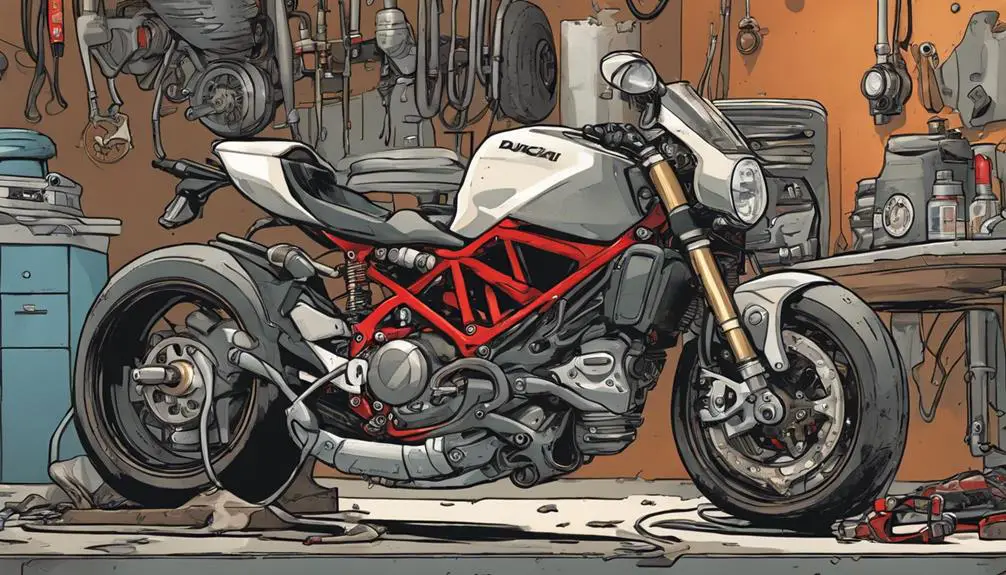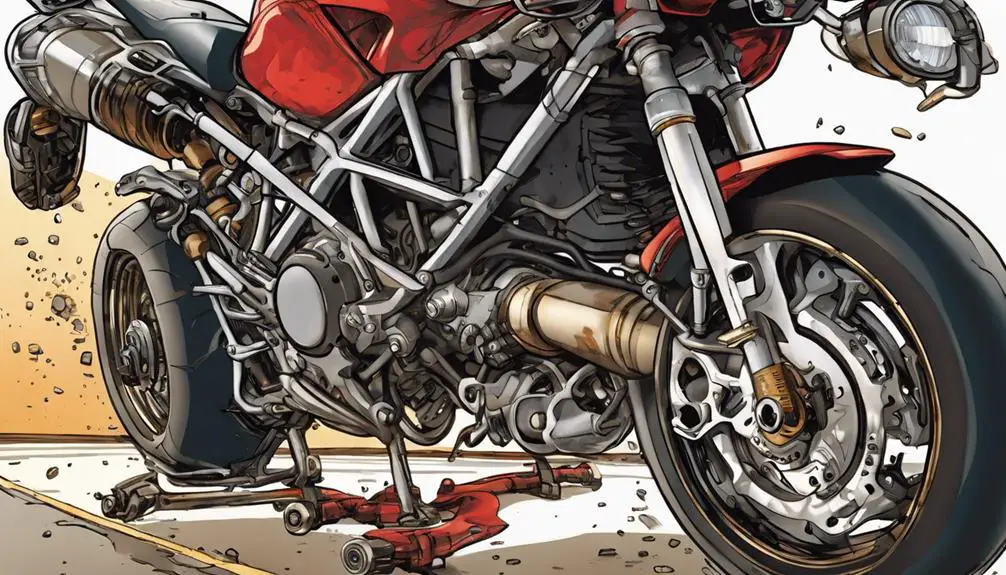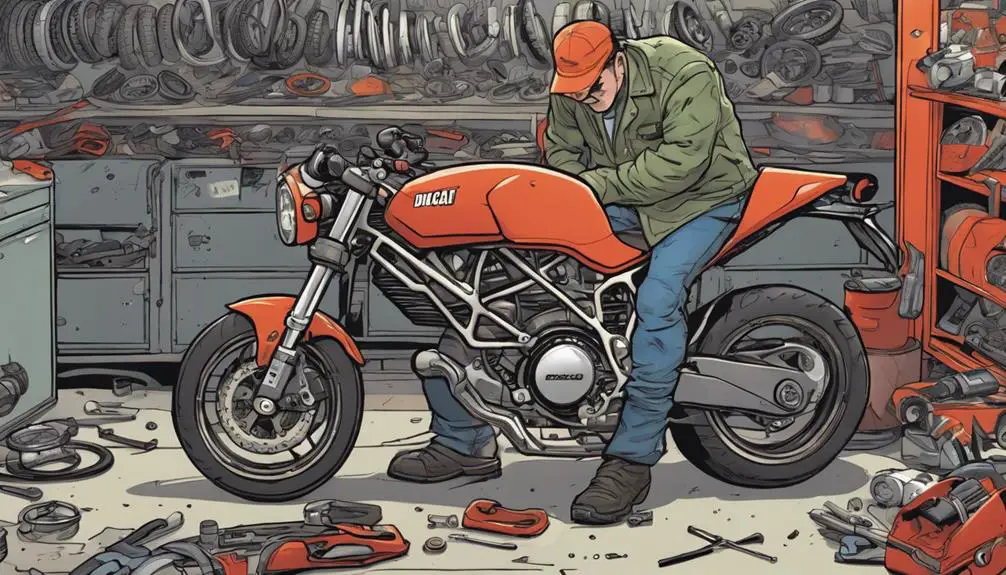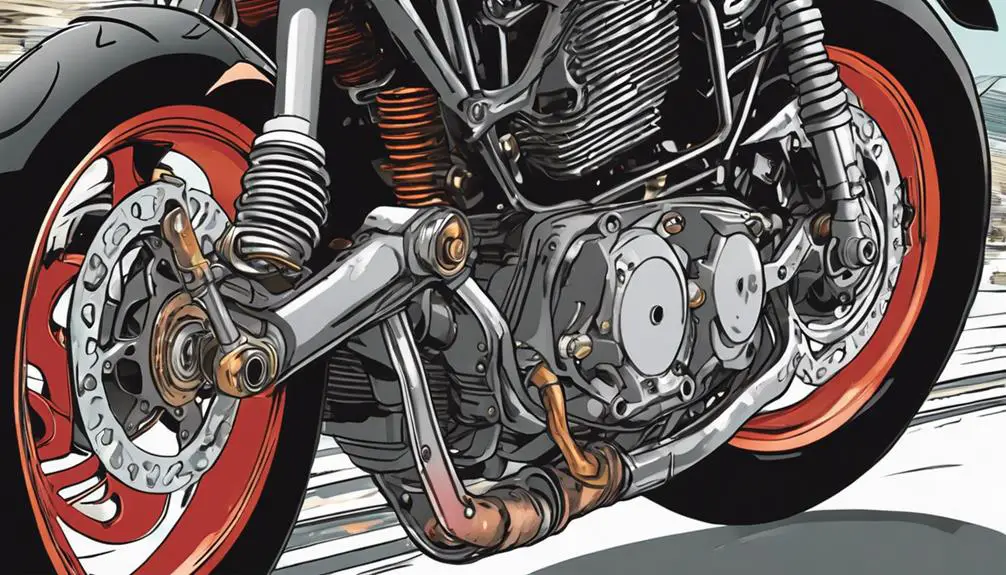When you're out on your Ducati, you might notice some handling quirks that just don't feel right. If you're experiencing instability in corners or excessive bouncing, it could be time to investigate. Pay attention to any unusual sounds or uneven tire wear—these could signal deeper suspension issues. Regular maintenance is key, but are you fully aware of what to look for? Let's explore the critical signs that could affect your ride's performance and safety.
Key Takeaways
- Look for unusual handling characteristics, such as excessive bouncing or instability, indicating potential suspension problems in your Ducati motorcycle.
- Inspect for abnormal noises like clunks or squeaks, which may suggest worn suspension components that need attention.
- Check for fluid leaks around fork seals or rear shocks, as these can significantly diminish performance and handling quality.
- Monitor tire wear patterns; uneven wear may point to misalignment or deeper suspension issues requiring immediate inspection.
Warning Signs of Suspension Issues

Keep an eye out for unusual handling or a bumpy ride, as these could signal potential suspension issues in your Ducati motorcycle. When you're carving through curves or cruising on open roads, you should feel a smooth connection to the asphalt. If your bike starts to feel unstable, it's time to take action.
Pay attention to any abnormal noises coming from the front or rear suspension. Clunking sounds or excessive squeaking can indicate worn components.
Also, notice if your bike leans more to one side; this imbalance can affect your ride considerably. When you hit bumps, how does your motorcycle react? If it feels overly harsh or doesn't absorb the shock as it should, your suspension may need attention.
Check for fluid leaks around the fork seals or rear shock. Any signs of leaking oil can lead to diminished performance.
Unusual Handling Characteristics
When riding your Ducati, you might notice signs of instability that can affect your confidence.
Changes in cornering performance and uneven tire wear are also key indicators that something's not right with your suspension.
It's crucial to address these unusual handling characteristics to keep your bike performing at its best.
Signs of Instability
Unusual handling characteristics in your Ducati can signal potential suspension issues, making it vital to recognize these signs early. If you feel your bike swaying or wobbling unexpectedly, it's a clear warning. This kind of instability can disrupt your freedom on the road, turning a thrilling ride into a nerve-wracking experience.
Pay attention to how your motorcycle responds during acceleration and deceleration. If it feels like it's pulling to one side, or if you struggle to maintain a straight line, your suspension might be compromised. Uneven tire wear is another critical indicator; if one side wears down faster than the other, it's time to investigate further.
You might also notice that your Ducati feels excessively bouncy or soft when hitting bumps, which can hamper your control. Listen for any unusual noises, like clunks or thuds, as these can indicate failing components.
Staying vigilant about these signs of instability not only keeps you safe but also preserves your sense of liberation as you ride. Your Ducati deserves the best, and addressing any suspension issues promptly will guarantee you can enjoy every twist and turn with confidence.
Cornering Performance Changes
Changes in cornering performance can often reveal underlying suspension problems in your Ducati that may not be apparent during straight-line riding.
You'll notice this when your bike doesn't respond as it should while leaning into corners, making you feel more like a passenger than a pilot. If your Ducati feels vague or unresponsive, it might indicate that the suspension isn't absorbing bumps effectively or that it's set up improperly.
When you push your limits, you might find your bike drifting wide or feeling unstable, robbing you of the freedom and confidence you desire on the road. You deserve a machine that inspires trust, allowing you to carve through curves with precision.
If you experience sudden changes in steering effort or if the bike feels overly enthusiastic to turn, it's time to dig deeper into your suspension setup.
Don't ignore these signs. Adjusting your suspension can release your Ducati's true potential, transforming your riding experience. Embrace the liberation that comes from a well-tuned setup, and reclaim the joy of spirited cornering.
After all, the open road is yours to conquer, and your Ducati should be your most trusted companion.
Uneven Tire Wear
Uneven tire wear on your Ducati can signal deeper suspension issues that affect how your bike handles on the road. If you notice that your tires are wearing down more on one side or developing bald spots, it's a call to action. Ignoring these signs could lead to compromised safety and an unenjoyable ride.
Take a moment to assess your bike's suspension setup. Here are a few things to evaluate:
- Check alignment: Misalignment can cause uneven pressure on tires, leading to premature wear.
- Inspect suspension components: Worn or damaged parts can disrupt the balance, impacting tire performance.
Addressing these issues not only extends the life of your tires but also enhances your riding experience. You'll regain that smooth, confident handling that makes riding your Ducati a true joy.
Don't let uneven tire wear hold you back; get your bike checked out to unlock its full potential on the open road.
Excessive Bouncing or Bottoming Out

If you're experiencing excessive bouncing or your Ducati is bottoming out, it's essential to identify the underlying causes.
You might notice specific signs indicating suspension issues that need attention.
Adjusting your suspension settings can often resolve these problems and enhance your riding experience.
Causes of Excessive Bouncing
Excessive bouncing in Ducati motorcycles often stems from worn-out suspension components or improper setup, which can make your ride feel unstable and uncomfortable. If you want to experience the thrill of the open road without the jarring interruptions, it's vital to identify these causes.
Here are a few key issues to keep in mind:
- Worn Shocks: Over time, your suspension can deteriorate, leading to inadequate dampening of road imperfections. This wear can result in excessive bouncing, robbing you of control.
- Incorrect Spring Rates: If the springs aren't suited to your weight or riding style, you might find the bike too stiff or soft, both of which can lead to a bouncy ride.
Signs of Bottoming Out
You might notice signs of bottoming out when your Ducati struggles to absorb bumps, causing a harsh jolt that disrupts your ride. This unsettling experience can feel like you're losing connection with the road, making it hard to enjoy that liberating thrill you crave. Pay attention to how your bike behaves over uneven terrain. If you find yourself bouncing excessively, it's a clear signal that your suspension isn't performing as it should.
Another sign is a noticeable decrease in comfort during rides. If every pothole feels like a jolt to your spine, it's time to investigate further. You may also hear unusual sounds, like clunks or thuds, which often accompany bottoming out. These noises indicate your suspension is hitting its limits, failing to keep you cushioned.
Additionally, if your Ducati feels unstable during turns or when riding over bumps, it's not just a minor inconvenience—it's a call to action. You deserve a smooth, exhilarating ride, and recognizing these signs is the first step toward reclaiming that freedom. Don't let suspension issues hold you back; embrace the power of awareness and take control of your journey.
Suspension Adjustment Techniques
To combat excessive bouncing or bottoming out on your Ducati, start by adjusting the suspension settings to better match your riding style and the terrain you'll encounter. It's all about finding that sweet spot where performance meets comfort.
Begin with the preload—this affects how the bike sits under your weight. If you're regularly riding solo, you might want to reduce it slightly, allowing for a firmer ride.
Next, turn your attention to the compression and rebound settings. These control how quickly the suspension reacts to bumps and dips in the road. If you're feeling too much bounce, try tightening the rebound to slow the spring's return. Conversely, if you're bottoming out, you may need to soften the compression a bit.
Remember, small adjustments can lead to a more liberated riding experience. Keep testing until you find what feels right for you!
- Adjust the preload to suit your weight and riding style.
- Experiment with compression and rebound settings for control.
Leaking Fork Seals
Leaking fork seals can lead to poor handling and decreased performance in your Ducati motorcycle. When oil seeps from the fork seals, it compromises the suspension's ability to absorb bumps and maintain contact with the road. You might notice a decrease in stability, especially during aggressive cornering or braking. This isn't just a minor annoyance; it can seriously affect your riding experience and safety.
To identify leaking fork seals, look for any oil residue around the forks. If you spot a film of oil or dirt clinging to the seals, it's time to take action. You might also hear a knocking sound or feel a roughness in the fork travel, both of which indicate that something's amiss.
Fortunately, fixing leaking fork seals isn't an insurmountable task. You can either replace the seals yourself with the right tools and a bit of patience or seek help from a qualified mechanic.
Either way, addressing this issue promptly will restore that exhilarating ride you crave and keep your Ducati performing at its best. Don't let leaking fork seals hold you back from the freedom of the open road!
Uneven Tire Wear Patterns

Addressing leaking fork seals can help prevent further complications, such as uneven tire wear patterns that can arise from improper suspension performance.
When your Ducati's suspension isn't functioning properly, it can lead to varying tire contact with the road, resulting in unpredictable and uneven wear. This not only affects your bike's handling but can also compromise your safety on the road.
To keep your ride smooth and liberating, pay attention to these signs of uneven tire wear:
- Cupping: Scalloped patterns on the tire surface signal that the suspension isn't absorbing shocks effectively.
- Edge Wear: If one side of your tire wears down faster, it could indicate misalignment or inadequate suspension settings.
Noises From the Suspension
You might often notice unusual noises coming from your Ducati's suspension, which can signal underlying issues that need attention. These sounds can range from clunks and rattles to squeaks and creaks, each hinting at different problems. Ignoring these noises isn't an option if you crave the freedom of a smooth ride.
If you hear a clunk when hitting bumps, it could indicate worn-out bushings or loose components. Squeaks might suggest a lack of lubrication in the joints, which can lead to bigger problems if left unchecked. Rattles often arise from loose bolts or parts, threatening the integrity of your suspension system.
To maintain that exhilarating connection with the road, you should address these sounds promptly. Regular inspections can help you identify and resolve these issues before they escalate. Remember, your Ducati is a masterpiece of engineering, and it deserves your attention to guarantee its performance remains uncompromised.
Diminished Ride Comfort

Diminished ride comfort can often stem from suspension issues that compromise the overall handling and feel of your Ducati. When your bike doesn't absorb bumps or imperfections in the road effectively, it can lead to a jarring experience that detracts from the freedom you seek while riding.
You may notice increased fatigue during longer rides, as well as reduced control when maneuvering turns and curves.
To regain that exhilarating ride, consider these key aspects:
- Check Your Sag: Proper sag settings guarantee your suspension is adequately tuned to your weight and riding style. An incorrect sag can lead to a harsh ride or poor handling.
- Inspect Shock Absorbers: Worn or leaking shock absorbers can greatly impact comfort. Look for signs of wear and replace them if necessary.
Adjustments Not Taking Effect
Even after making adjustments to your suspension setup, you might still notice that the changes aren't translating into improved ride quality. This frustrating situation can feel like a cage, holding you back from experiencing the freedom your Ducati promises.
First, double-check your adjustments. Sometimes, it's easy to overlook simple settings like preload or compression. Make sure you've got the right measurements for your weight and riding style. If you're still not feeling a difference, consider the possibility that your suspension components might be worn out or damaged.
Next, confirm you're using high-quality fluids and that the seals are intact. Contaminated or old oil can compromise performance, preventing your adjustments from taking effect.
Lastly, don't hesitate to consult with a professional. They can provide insights and perform a thorough inspection, liberating you from the guesswork. Remember, your Ducati is meant to deliver a thrilling ride, and you deserve to experience every exhilarating moment. By addressing these issues, you can reclaim the ride quality you seek, releasing the full potential of your motorcycle.
Frequently Asked Questions
How Often Should I Check My Ducati's Suspension Components?
You should check your motorcycle's suspension components regularly to guarantee peak performance and safety. Aim for at least every 3,000 miles or before long rides.
Pay attention to any changes in handling or feel, as these can indicate issues. It's all about feeling connected to your ride and enjoying the freedom of the open road.
Regular checks will keep your bike performing at its best, allowing you to embrace every journey with confidence.
What Tools Are Needed for Basic Suspension Maintenance?
For basic suspension maintenance, you'll need a few essential tools.
Grab a socket set and a torque wrench to guarantee everything's tightened correctly.
A flathead and Phillips screwdriver will help with adjustments.
Don't forget a measuring tape for checking sag and ride height.
Finally, suspension fluid and a funnel are vital for oil changes.
With these tools, you're ready to plunge into your maintenance and keep your ride performing at its best!
Can I Adjust My Suspension Settings Without Professional Help?
Adjusting your suspension settings is like tuning a musical instrument; it requires a bit of finesse and understanding.
You can absolutely do it without professional help, but take your time. Start by familiarizing yourself with your bike's manual and use basic tools.
Experiment with settings gradually, and pay attention to how it feels. Trust your instincts, and you'll find the setup that liberates your ride, enhancing both comfort and control.
What Are the Common Causes of Suspension Issues in Ducati Motorcycles?
When it comes to suspension issues, you'll often find common culprits like worn-out bushings, leaking seals, or improper adjustments.
If your ride feels bouncy or unsteady, it might be time to check those components.
You might also face issues from debris clogging the dampers or from improper preload settings.
Keeping an eye on these factors can help guarantee a smoother, more liberated ride, allowing you to enjoy the freedom of the open road.
How Can I Tell if My Suspension Has Been Modified?
To tell if your suspension's been modified, start by inspecting it closely.
Look for unusual components or adjustments that don't match the original specs. Check for different springs, dampers, or altered ride height.
You might also notice changes in handling or ride comfort. If you're unsure, consult a professional who can provide insight.
Trust your instincts; if something feels off, it's worth investigating further. Your ride should feel just right!
Conclusion
Just like a skilled dancer needs a sturdy floor to perform, your Ducati thrives on a well-tuned suspension.
If you spot any of the warning signs—like unusual handling or unsettling noises—don't ignore them. They're your bike's way of whispering for help.
Tending to these issues not only enhances your ride but guarantees your motorcycle gracefully glides through every twist and turn.
Keep your Ducati in tune, and it'll reward you with a performance that feels like poetry in motion.